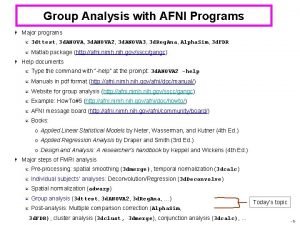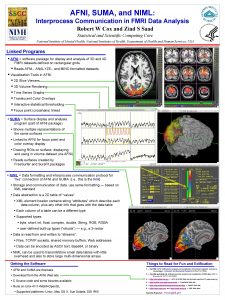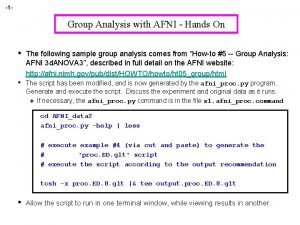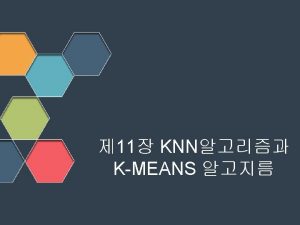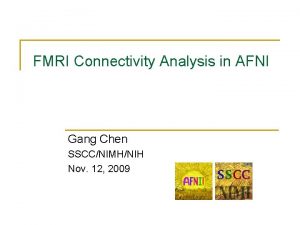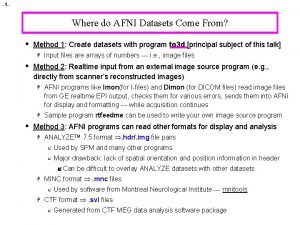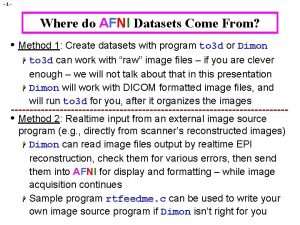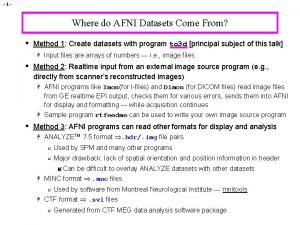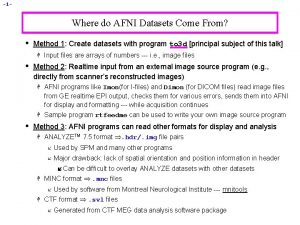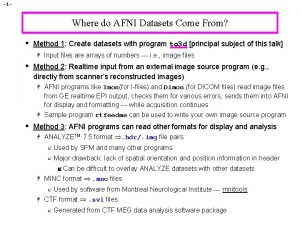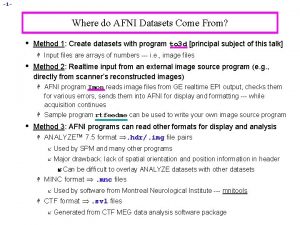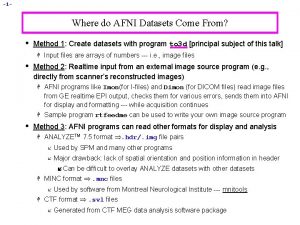1 Where do AFNI Datasets Come From Method




![-5 - Example 2 – run_Dimon. csh uniq_images I*[0123456789] > uniq_image_list. txt Dimon -infile_list -5 - Example 2 – run_Dimon. csh uniq_images I*[0123456789] > uniq_image_list. txt Dimon -infile_list](https://slidetodoc.com/presentation_image_h/30fe366235390c695c4c3b26eb185df0/image-5.jpg)
![-6 - Example 2 – run_Dimon. csh – Unique Images uniq_images I*[0123456789] > uniq_image_list. -6 - Example 2 – run_Dimon. csh – Unique Images uniq_images I*[0123456789] > uniq_image_list.](https://slidetodoc.com/presentation_image_h/30fe366235390c695c4c3b26eb185df0/image-6.jpg)
![-7 - Example 2 – run_Dimon. csh – Sorting Input Files uniq_images I*[0123456789] > -7 - Example 2 – run_Dimon. csh – Sorting Input Files uniq_images I*[0123456789] >](https://slidetodoc.com/presentation_image_h/30fe366235390c695c4c3b26eb185df0/image-7.jpg)
![-8 - Example 2 – run_Dimon. csh – Other Details uniq_images I*[0123456789] > uniq_image_list. -8 - Example 2 – run_Dimon. csh – Other Details uniq_images I*[0123456789] > uniq_image_list.](https://slidetodoc.com/presentation_image_h/30fe366235390c695c4c3b26eb185df0/image-8.jpg)




- Slides: 12

-1 - Where do AFNI Datasets Come From? • Method 1: Create datasets with program to 3 d or Dimon H H to 3 d can work with “raw” image files – if you are clever enough – we will not talk about that in this presentation Dimon will work with DICOM formatted image files, and will run to 3 d for you, after it organizes the images • Method 2: Realtime input from an external image source program (e. g. , directly from scanner’s reconstructed images) H Dimon can read image files output by realtime EPI reconstruction, check them for various errors, then send them into AFNI for display and formatting – while image acquisition continues H Sample program rtfeedme. c can be used to write your own image source program if Dimon isn’t right for you

-2 - Creating AFNI Datasets with Program Dimon • Dimon reads DICOM image files and assembles them into AFNI datasets (using program to 3 d) H Can also read GEMS 5. x I-files; plus Ni. FTI and AFNI datasets if needed • The collection of all 2 D slice data forms the. BRIK file H An AFNI dataset can contain a single slice • Dimon has many different ways of being run, to deal with different situations that come up in the input files • But we will only have 2 simple examples (next slides) • Program dicom_hdr is used to write out a formatted table of the header information from a DICOM file H This information can help when there are problems å Sample output near end of presentation

-3 - Example 1 – EPI Time Series • Switch to the directory with the sample data: H cd ~/AFNI_data 6/EPI_run 1 • Run this command H Dimon -infile_prefix 8 HR -gert_create_dataset • The Dimon program does these things: • Scan the input files (all files with names starting with 8 HR), determines where each 3 D volume ends (one TR) • Runs to 3 d to assemble all the input files into one AFNI dataset, with 68 3 D volumes, each one with 34 slices • Saves the dataset with a default prefix name Out. Brick_run_003+orig • You can choose the output prefix yourself – see next example

-4 - Example 2 – T 1 -Weighted Anatomical Volume • Switch to the directory with the sample data: H cd ~/AFNI_data 6/DICOM_T 1 • Run this command (almost the same as Example 1) H Dimon -infile_prefix I -gert_create_dataset • The Dimon program fails! • The reason: the filenames (I 1000000, I 1000001, …) are not in the correct order to make up a 3 D volume • To see this disorder (chaos ), run command aiv I* and scroll through the slices (aiv = AFNI Image Viewer) • To fix this problem, the run_Dimon. csh script was written • To run this script, type tcsh run_Dimon. csh • See next slide for script
![5 Example 2 runDimon csh uniqimages I0123456789 uniqimagelist txt Dimon infilelist -5 - Example 2 – run_Dimon. csh uniq_images I*[0123456789] > uniq_image_list. txt Dimon -infile_list](https://slidetodoc.com/presentation_image_h/30fe366235390c695c4c3b26eb185df0/image-5.jpg)
-5 - Example 2 – run_Dimon. csh uniq_images I*[0123456789] > uniq_image_list. txt Dimon -infile_list uniq_image_list. txt -gert_create_dataset -gert_write_as_nifti -gert_to 3 d_prefix T 1. 3 D -gert_outdir. . -dicom_org -use_last_elem -save_details Dimon. details -gert_quit_on_err
![6 Example 2 runDimon csh Unique Images uniqimages I0123456789 uniqimagelist -6 - Example 2 – run_Dimon. csh – Unique Images uniq_images I*[0123456789] > uniq_image_list.](https://slidetodoc.com/presentation_image_h/30fe366235390c695c4c3b26eb185df0/image-6.jpg)
-6 - Example 2 – run_Dimon. csh – Unique Images uniq_images I*[0123456789] > uniq_image_list. txt Dimon -infile_list uniq_image_list. txt -gert_create_dataset • From the list of input image files, creates a list of files -gert_write_as_nifti with unique images • To avoid a problem where systems can -gert_to 3 d_prefix T 1. 3 D output more than one copy of the same image file, but with different -gert_outdir. . names -dicom_org -sort_by_acq_time • The use of uniq_images is not needed in this example, but it was needed in some -use_last_elem other data from the same scanner Dimon. details -save_details -gert_quit_on_err
![7 Example 2 runDimon csh Sorting Input Files uniqimages I0123456789 -7 - Example 2 – run_Dimon. csh – Sorting Input Files uniq_images I*[0123456789] >](https://slidetodoc.com/presentation_image_h/30fe366235390c695c4c3b26eb185df0/image-7.jpg)
-7 - Example 2 – run_Dimon. csh – Sorting Input Files uniq_images I*[0123456789] > uniq_image_list. txt Dimon -infile_list uniq_image_list. txt -gert_create_dataset -gert_write_as_nifti -gert_to 3 d_prefix T 1. 3 D -gert_outdir. . -dicom_org -use_last_elem • Tells Dimon to organize the image files by the information stored in their DICOM headers, rather than by filenames -save_details Dimon. details • This step usually fixes problems with slices being out of order -gert_quit_on_err when the scanner (or PACS) creates the filenames
![8 Example 2 runDimon csh Other Details uniqimages I0123456789 uniqimagelist -8 - Example 2 – run_Dimon. csh – Other Details uniq_images I*[0123456789] > uniq_image_list.](https://slidetodoc.com/presentation_image_h/30fe366235390c695c4c3b26eb185df0/image-8.jpg)
-8 - Example 2 – run_Dimon. csh – Other Details uniq_images I*[0123456789] > uniq_image_list. txt Dimon -infile_list uniq_image_list. txt -gert_create_dataset -gert_write_as_nifti -gert_to 3 d_prefix T 1. 3 D -gert_outdir. . -dicom_org -use_last_elem • Prefix for output dataset • Write in parent directory -save_details Dimon. details -gert_quit_on_err • Write Ni. FTI output

-9 - Other Dimon Options • -dicom_org tells Dimon to “organize” the files • Which can be used when all the files in one directory might be from different imaging runs and need to be put into different datasets • -sort_method XXX tells Dimon how to sort the files for arrangement in space and time (if -dicom_org does not work) • Most useful possibilities for XXX are default and acq_time • -save_details PREFIX tells Dimon to save the information about how the DICOM files are organized (into a few files whose names start with PREFIX) • So you can look at this information when there is a problem • If you need help from us, we will need these details

-10 - How to Use Dimon at Your Site • Experiment with the program until it works for your DICOM files • Read the help and ask for help on the AFNI message board • Write a script that makes AFNI or Ni. FTI datasets from the files you get from your scanner • Keep using that script forever, or until it stops working for you • Advanced Usage: • You can use the “realtime” options (-rt -host …) to read DICOM files written out during scanning • And Dimon will send them into the AFNI graphical interface, so you can look at the data and at subject head movement while the subject is still being scanned • AFNI_data 6/realtime. demos has 2 examples, with scripts showing how to run Dimon sending realtime data to AFNI

-11 - • Example 3 – Using dicom_hdr This program is for finding information in the DICOM header of an image file • • dicom_hdr I 9900000 | more (in directory DICOM_T 1/) Small part of the output (describes 2 D image format) Group: 0028, Length: 200 0028 0002 2 [2864 ] // IMG Samples Per Pixel// 1 0028 0004 12 [2874 ] // IMG Photometric Interpretation//MONOCHROME 2 0028 0010 2 [2894 ] // IMG Rows// 256 0028 0011 2 [2904 ] // IMG Columns// 256 0028 0030 14 [2914 ] // IMG Pixel Spacing//0. 9375�. 9375 0028 0100 2 [2936 ] // IMG Bits Allocated// 16 0028 0101 2 [2946 ] // IMG Bits Stored// 12 0028 0102 2 [2956 ] // IMG High Bit// 11 0028 0103 2 [2966 ] // IMG Pixel Representation// 0 0028 1050 2 [2976 ] // IMG Window Center//94 0028 1051 4 [2986 ] // IMG Window Width//164 0028 1052 2 [2998 ] // IMG Rescale Intercept//0 0028 1053 2 [3008 ] // IMG Rescale Slope//1 Group: 7 fe 0, Length: 131080 7 fe 0 0010 131072 [17920] // PXL Pixel Data//Data on disk

-12 - Another Program to Try – dcm 2 niix • dcm 2 niix = DICOM to Ni. FTI converter • https: //www. nitrc. org/projects/dcm 2 nii/ • https: //github. com/neurolabusc/dcm 2 niix • It works with more DICOM formats than Dimon does • For example, color images (from perfusion studies) • Philips PAR/REC format files • dcm 2 niix is not from the AFNI group • It is from Chris Rorden at University of South Carolina (USA) • Someday soon, we will include it with AFNI • One advantage of using Dimon • Creates datasets (AFNI or Ni. FTI formats) with extra information in the header

